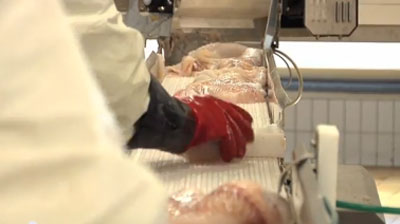| Jan 28, 2014 |
Filleting robot to help the Norwegian fishing industry
|
|
(Nanowerk News) A newly developed white fish filleting machine could give this Norwegian industry a much-needed boost.
|
|
Unlike farmed salmon, white fish varies greatly in size and weight. This means that until now, no one has been able to develop a machine that can fillet these fish.
|
|
However, there is now a filleting machine that could result in a positive upturn in the Norwegian fishing industry. The machine is a result of a development project run by Nordic Innovation, in which Sintef, Marel, Faroe Origin and Norway Seafoods have been working together.
|
 |
| The new machine locates the fish bones using X-ray technology, and fillets the fish quickly and precisely with a powerful jet of water.
|
|
Getting the bones out
|
|
White fish is complicated and time-consuming to fillet, because the bones are difficult to find and remove. As a result, three to seven per cent of the most valuable part of the fish is currently cut away unnecessarily.
|
|
Researchers at SINTEF ICT have conducted X-ray tests in the laboratory, and have used CP scanners at Oslo University Hospital to learn more about where fish bones are located.
|
|
The technology focuses on image analysis and recognition. The new machine locates the fish bones using X-ray technology, and fillets the fish quickly and precisely with a powerful jet of water. This means that the fish is guaranteed to be boneless, with considerably less wastage than with manual filleting.
|
|
Processing in Norway
|
|
"Norway only exports 10 to25 per cent of processed products – depending on whether it is white fish or farmed fish", says Marit Aursand, Research Director of SINTEF Fisheries and Aquaculture.
|
|
"Most of our most important seafood products – such as salmon, cod and herring – receive only minimal processing or treatment before they are sent abroad. In other words, the potential for carrying out more processing in Norway is huge, and this robot could provide a breakthrough, giving us a much-needed competitive advantage over low-cost countries in Asia, Eastern Europe and Russia", says Aursand.
|
|
Currently, fish caught in Lofoten may travel through two other countries for filleting and packing before it returns to Norway. But this new invention would make it possible to send fresh fish direct to the shops from Norwegian facilities.
|
|
"Fish processing in Norway will soon become a thing of the past if the filleting process is not automated and made efficient and profitable. This is why this new invention is so important. It means that we can improve the quality and selection of fresh fish products, and keep the industry on Norwegian soil", says Aursand.
|

